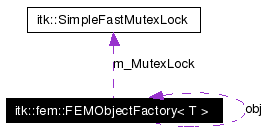
#include <itkFEMObjectFactory.h>
Collaboration diagram for itk::fem::FEMObjectFactory< T >:

Static Public Member Functions | |
| T::Pointer | Create (int id) |
| StrClassName | ID2ClassName (int id) |
| int | Register (COF f, const char *str) |
| int | ClassName2ID (StrClassName str) |
Friends | |
| class | Dummy |
ObjectFactory is used to create various objects of derived classes by specifying an ID of a derived class. Before the objects can be created by object factory, you should first call the Register method for each class:
int ID_Derived=FEMObjectFactory.Register( NewDerivedClass, "NewDerivedClassName" );
You should also put the NewDerivedClass function in an anonymous namespace and make it static. So a complete registration of a derived class looks like:
Definition at line 67 of file itkFEMObjectFactory.h.
|
||||||||||
|
Find the ID of the class with specified name (this is a slow function). If you have to create many objects of the same class, obtain the class ID with this function first and then use that ID with the Create member function. Definition at line 127 of file itkFEMObjectFactory.h. |
|
||||||||||
|
Create a new object based on class identifier id and return a pointer to it. Definition at line 92 of file itkFEMObjectFactory.h. |
|
||||||||||
|
Return the name of the class (as a string) for the given ID. Definition at line 116 of file itkFEMObjectFactory.h. |
|
||||||||||||||||
|
Register the class with the factory. A pointer to a 'create' function and class name as a string must be provided. Function returns the newly assigned ID of the class, which can be later used to create objects of that class. Definition at line 102 of file itkFEMObjectFactory.h. |
|
|||||
|
By defining a Dummy friend class, some warnings in gcc about destructor being private are eliminated. Definition at line 195 of file itkFEMObjectFactory.h. |
 1.3.5 written by Dimitri van Heesch,
© 1997-2000
1.3.5 written by Dimitri van Heesch,
© 1997-2000